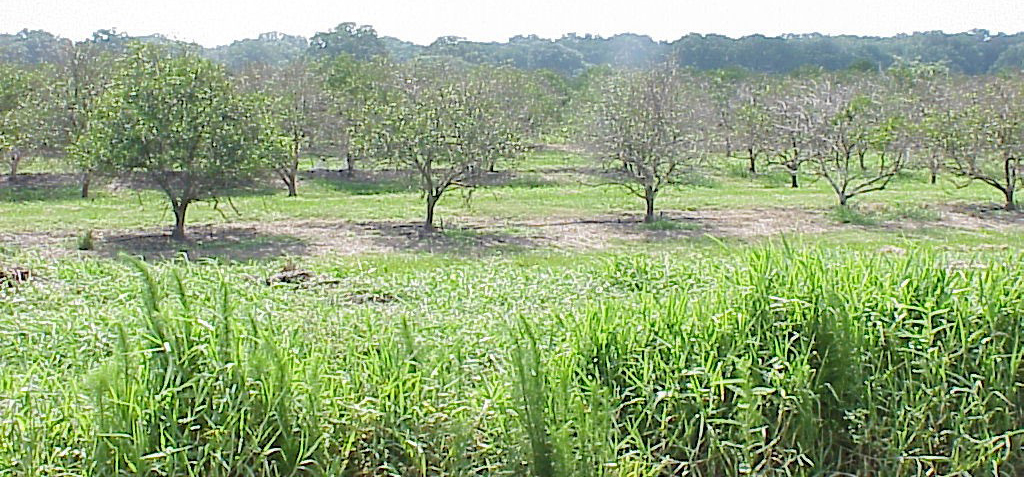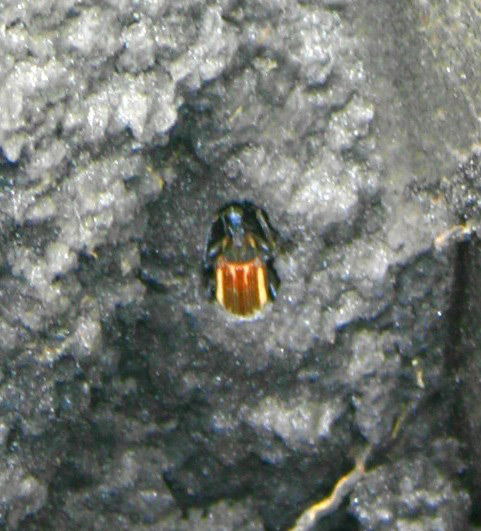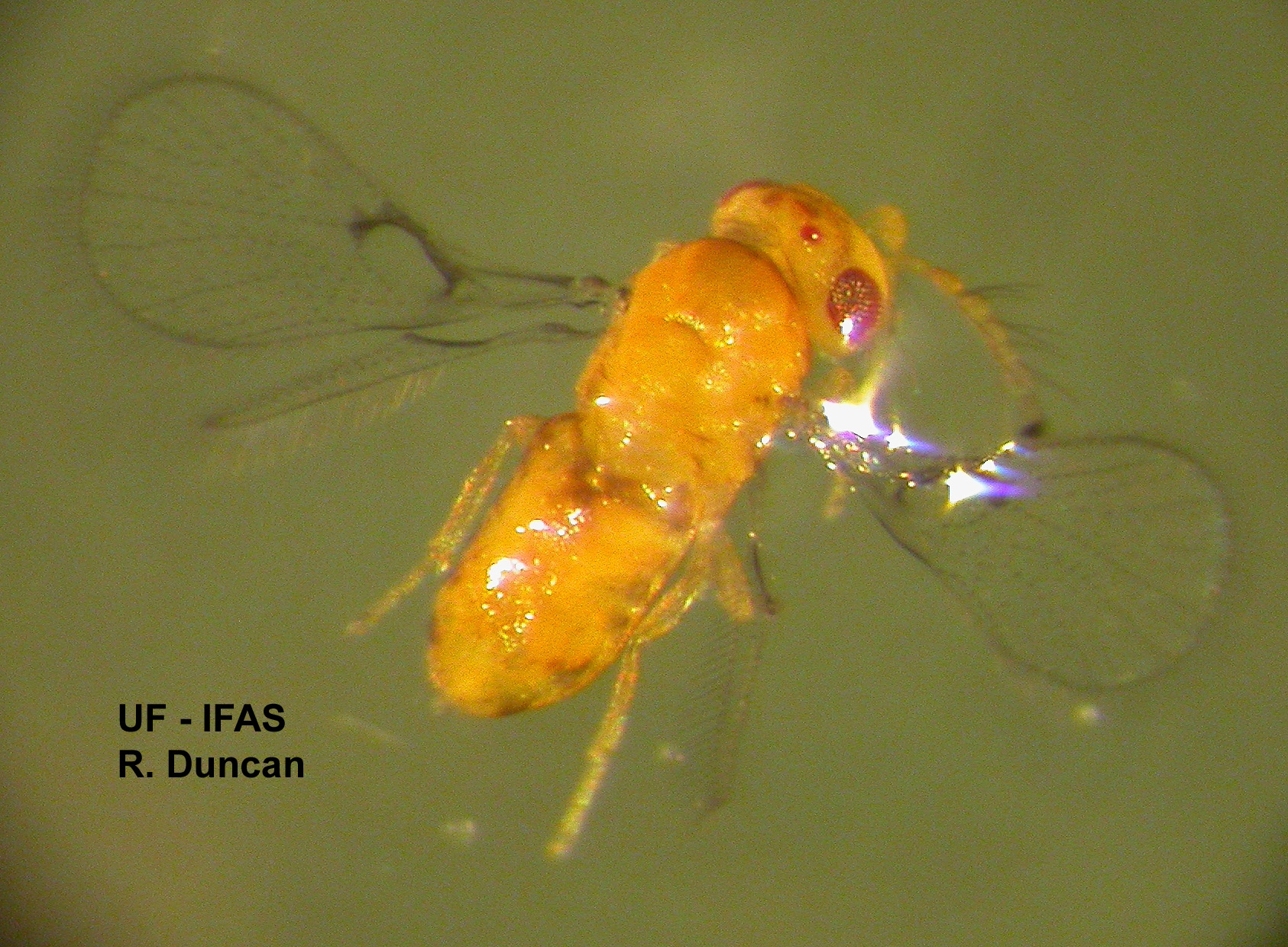The Diaprepes Root Weevil
(Diaprepes abbreviatus) is a major pest of crops and ornamental plants in Florida and the Caribbean Basin. The Diaprepes Task Force was organized in 1993 to coordinate and facilitate research, education and regulatory efforts to manage this pest more efficiently.
Diaprepes Task Force members include growers as well as scientists and administrators from Florida Department of Agriculture and Consumer Services - Division of Plant Industry, the University of Florida - Institute of Food and Agriculture Sciences, and the United States Department of Agriculture - Agriculture Research Service.

Battling the Evil Weevil:
Recent Advances in the War on Diaprepes abbreviatus
Robin J. Stuart and Michael E. Rogers
This article appeared in Citrus Industry 87: 7-11 (2006).
The Diaprepes root weevil, Diaprepes abbreviatus, was first detected in Florida over 40 years ago and continues to be a major cause of tree decline and death in certain citrus growing areas across the state. Its persistence as an important pest can be attributed to various factors: the broad range of crop, ornamental, and weedy plants it utilizes for adult feeding, egg laying and larval development; its often asynchronous, highly variable and complex life history; a relatively large and long-lived larval stage that can cause severe damage to major tree roots; the facilitation of Phytophthora infection by larval feeding; the ineffectiveness of many pesticides against soil-dwelling larvae; and the limited, often patchy distributions of important natural enemies. Here we provide an update on some of the current research and recent discoveries that are contributing to our battle against Diaprepes, and that might soon reduce this evil weevil to little more than a benign and occasionally viewed visitor to Florida citrus groves.

Economic Impact Varies Across Regions
Fortunately, in certain areas of the state, most notably certain parts of the central ridge, Diaprepes populations generally appear to be under good natural control, probably by an array of natural enemies. However, off the ridge in many finer textured and less well-drained soils, Diaprepes continues to be a major problem. Research efforts to identify and characterize problem areas, and to develop and test new strategies or combinations of strategies to suppress the weevil and maintain grove productivity are continuing.

An area-wide survey of the seasonal abundance of adult Diaprepes at six sites in different regions of Florida by Steve Futch (UF-IFAS) found that population densities of Diaprepes were five times higher in orchards growing on shallow soils in the coastal and central flatwoods than in orchards on the deep sandy soils of the central ridge. These results agree with regional trends in Diaprepes abundance reported by researchers and citrus growers. The causes of regional variation in Diaprepes abundance are unknown but merit research because the profitability of most tactics to manage the insect is directly related to pest pressure. Moreover, the recognition of the various biotic or abiotic factors that regulate or limit the abundance of the insect could contribute to novel management strategies. Recent investigations indicate that entomopathogenic nematodes are much more abundant on the ridge than in the flatwoods and exert a much higher level of natural control on Diaprepes larvae on the ridge (Larry Duncan, UF-IFAS). The incidence of Phytophthora also differs with ridge and well-drained flatwoods groves more likely to be infested by P. nicotianae whereas poorly drained flatwoods groves are more likely to harbor P. palmivora (Jim Graham, UF-IFAS).

Soil Variability
Even within groves, the distribution of root weevils can be heterogeneous, and studies are addressing relationships between Diaprepes abundance and soil characteristics. In a poorly drained citrus grove in central Florida, Hong Li and Jim Syvertsen (UF-IFAS) found that the abundance of Diaprepes adults was highest in high elevation areas and was negatively correlated with soil Mg and Ca. The results suggest that soil liming, site elevation, soil flooding, and rain or water erosion might be factors influencing Diaprepes distributions within sites. A study in an east coast grove by Bob Adair (FLARES), Jim Graham (UF-IFAS) and Arnold Schumann (UF-IFAS) showed that soil electro-conductivity was related to spatial patterns of Diaprepes and Phytophthora populations, and to decline of Swingle citrumelo and Cleopatra mandarin rootstocks.

Rootstock Tolerance
Research by Jude Grosser and Jim Graham (UF-IFAS) is directed toward developing new rootstocks that are able to recover from Diaprepes feeding damage, are resistant to Phytophthora nicotianae and P. palmivora, and can grow into productive trees in a wide range of soils, especially those high in clay and calcareous materials that characterize the flatwoods. Trifoliate orange hybrids, such as Swingle citrumelo and Carrizo citrange, with good resistance to P. nicotianae, are not showing adequate resistance to P. palmivora. Therefore, emphasis is being placed on non-trifoliate based somatic and sexual hybrids. In field trials on a high pH calcareous site that is heavily infested with Diaprepes, two pummelo-based somatic hybrids are out-performing other material. These hybrids apparently do not share the usual problems associated with the use of diploid pummelos as rootstocks (i.e., excessively large but poor yielding trees). The results suggest the potential for pummelo-derived material as an alternative to sour orange (which has been lost due to CTV quick decline) in areas with heavy Diaprepes pressure. Intensive efforts during the past four years have generated a large amount of genetically diverse material, and the screening of this material in greenhouse and field trials is continuing.
Strategic Pesticide Applications Enhance Rootstock Tolerance
An ongoing long-term field study in a central Florida grove on a fine-textured soil heavily infested with Diaprepes has shown that both rootstock selection and a limited pesticide application program can be important for maintaining citrus groves under stress from Diaprepes and Phytophthora nicotianae (Clay McCoy, Robin Stuart, Bill Castle, and Michael Rogers, UF-IFAS). In this grove, Phytophthora resistant rootstocks such as Swingle citrumelo and C35 citrange are outperforming more susceptible rootstocks such as Cleopatra mandarin. Moreover, pesticide applications with activity against the egg and adult stages of Diaprepes applied twice during the weevil’s spring emergence peak effectively suppress weevil populations on treated trees and enhance the growth, survival and yield of trees on the best performing rootstocks. This study reinforces the view that the Phytophthora/Diaprepes complex can kill trees on all rootstocks but that vigorous rootstocks with resistance to Phytophthora can better tolerate high weevil populations, especially when assisted by strategic pesticide use to suppress adult weevils during critical periods. A limited pesticide program such as this could be cost effective and is likely to be less destructive to natural enemies.
Movement and Longevity
Although Diaprepes was first detected in Florida in 1964, and was considered a pest in the Caribbean for many years previously, there are still important gaps in our knowledge of the biology of this insect. For example, we have little idea to what extent Diaprepes adults move in citrus groves, or how long adults normally live under field conditions. Since Diaprepes adults are highly polyphagous and prefer citrus flush to older leaves, they would be expected to move in response to food availability and flushing cycles within groves, perhaps migrating to and from groves in response to food availability. Some observations suggest that adults might move a great deal, especially at night, and laboratory data

indicate that adults might sometimes live for over a year (Herb Nigg, UF-IFAS). In a current study by Robin Stuart and Michael Rogers (UF-IFAS), young weevils are trapped in cone traps as they emerge from soil, individually marked using numbered color-coded bee tags and paint marks, and released back into the grove at the site of emergence. The weevils are later recovered during routine population monitoring in Tedders traps and during tree shaking. Information from this study could contribute to control strategies and help researchers plan experimental plot sizes, interpret population monitoring data, and make predictions regarding the dynamics of Diaprepes infestations.

Entomopathogenic Nematodes
Commercially produced entomopathogenic nematodes have been used by Florida growers to help control root weevils for over 15 years and are the only recommended control for Diaprepes larvae feeding on tree roots in the soil. The use of this weevil control strategy in Florida citrus is considered a biological control success story but current research could make this strategy even more effective. Steinernema riobrave has proven to be one of the best entomopathogenic nematodes for use in applications against Diaprepes but until recently only a single strain of this species was known. This original strain was isolated in the Rio Grande Valley of Texas and Clay McCoy (UF-IFAS), Robin Stuart (UF-IFAS), and David Shapiro-Ilan (USDA-ARS) revisited that area, took soil samples, and isolated 10 new strains of S. riobrave. Laboratory tests demonstrated that some of the new strains were significantly more virulent to Diaprepes larvae than the previous strain. If this increased virulence carries over to field trials then the new strains might improve current nematode products. Recently, Biocontrol Systems, Inc., (Greendale, IN) licensed two of the new strains for further product development for citrus and other crops. Additional studies by Larry Duncan (UF-IFAS) are examining how nematode applications impact natural weevil control by endemic nematodes, and how physical habitats and natural enemies affect nematode abundance in different parts of the state. Naturally occurring nematode communities appear to provide significant levels of biological control of Diaprepes in certain areas but not in others, and it might be possible to develop new strategies to increase nematode effectiveness in problematic sites by discovering what factors limit nematode abundance.
Egg Parasitoids
A classical biological control program in which parasitic wasps that attack Diaprepes egg masses within their native range in the Caribbean are reared and released in Florida has produced promising results (Jorge Pena, UF-IFAS). Two wasp species (Aprostocetus vaquitarum and Quadrastichus haitiensis) have become established in south Florida where they are responsible for weevil egg mortality of 70-80%. Unfortunately, these species are highly tropical, will not survive temperatures below 15°C, and have not been successful further north in major citrus growing areas. However, two additional wasp species that are more cold tolerant (Fidiobia dominica and Haeckeliania sperata) were recently discovered on the island of Dominica and are scheduled for release across Florida in 2006. Hopefully these species will find citrus groves throughout Florida more to their liking.

Predators
Ants are recognized as important predators of insect pests in various agroecosystems, and are managed and conserved for biological control in integrated pest management programs. In Florida, ants are among the major predators of Diaprepes eggs, larvae, and adults, and research shows that several ant species, especially Solenopsis invicta (the red imported fire ant) and Pheidole moerens , are effective predators of Diaprepes neonates on the soil surface (Robin Stuart and Clay McCoy, UF-IFAS). Current research is examining the positive and negative impacts of different ant species in citrus, how the abundance and distribution of different ant species varies in response to grove management practices, and what manipulations might be effective to conserve or enhance beneficial ant species (Robin Stuart and Michael Rogers, UF-IFAS). This information is necessary to maximize the effectiveness of ant predation on Diaprepes and to enable growers to make informed decisions about alternative pest control tactics.

Pathogens
An Iridovirus is currently being investigated for its potential use in Diaprepes control (Wayne Hunter, USDA-ARS). This virus is passed between weevils during mating and reduces the lifespan and fecundity of infected individuals. The main obstacle to the use of this virus is the development of a cost effective method for mass production. However, technological advances could soon remedy this problem and make the virus available for biological control programs.
Genetic Engineering and Transferable Resistance
Research indicates that Diaprepes is susceptible to toxins produced by certain strains of the bacterial pathogen, Bacillus thuringiensis, better know as Bt (Allen Weathersbee, USDA-ARS). This discovery raises the possibility of genetically engineering rootstocks to express the toxin as a means of controlling root weevil larvae. An additional study is testing the effectiveness of various types of genetically engineered Bt corn (Monsanto Co., St. Louis, MO) for their effectiveness against root weevil larvae (Michael Rogers, UF-IFAS). A program is also underway to examine the possibility of using the protein inhibitors of certain Diaprepes digestive enzymes to reduce weevil growth and survival (Charles Powell, UF-IFAS). A trypsin inhibitor from mosquitoes inhibits root weevil trypsin synthesis and reduces the growth of Diaprepes larvae that feed on transgenic alfalfa plants that express the inhibitor in laboratory tests. Plans are underway to test this transgenic alfalfa on weevils in greenhouse studies and to determine whether it could be used as a trap crop in citrus groves.
New Fronts in the Battle
The Diaprepes root weevil has demonstrated the capacity to spread and become established in new areas through the movement of ornamentals or nursery material and by hitchhiking on or in long distance transports. Originally from the Caribbean, this weevil has spread to at least 23 counties in Florida and a limited area in the Rio Grande Valley of Texas. The weevil has also been intercepted and destroyed numerous times in shipments of plants in truck trailers and the cargo holds of aircraft in California, and it turned up in the Mall of America and a botanical garden in Britain. During the past year in California, it was found in residential areas of Orange, Los Angeles, and San Diego Counties, where it is currently the subject of quarantine and eradication programs by the California Department of Food and Agriculture.
To date, Diaprepes has proven to be a formidable foe, but the solution to the Diaprepes problem could be at hand in one or more of these research projects. The battle continues.
